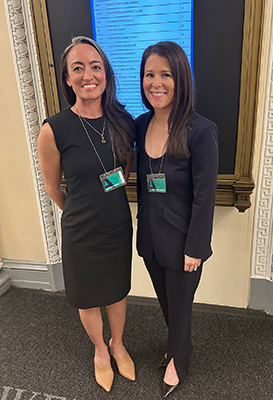Jun 17, 2024
Green presents tax research results to White House Council of Economic Advisers
Gies College of Business professor Danielle Higgins Green visited the White House to present the findings of a recent research paper, which could have wide-ranging effects on the United States tax system. Green and her coauthors Erin Henry (University of Arkansas) and George Plesko (University of Connecticut) spoke with the White House Council of Economic Advisers (CEA) about their study, “The Demographics of the CAMT: Insights from Tax Return Data,” which is forthcoming in the National Tax Journal.

“Presenting our research to the CEA was a remarkable opportunity as they directly advise the President on economic and tax policies,” Green said. “It validates our work to know that our research could shape policymakers' perspectives on the effectiveness of the new law. This experience is undoubtedly a highlight in my career as a tax researcher.”
The study researches the potential effects of the Corporate Alternative Minimum Tax (CAMT), which was enacted by the Biden Administration in 2023. The CAMT imposes a 15 percent US corporate minimum tax on the adjusted financial statement earnings (AFSI) of US companies that average $1 billion in AFSI for three consecutive years and on foreign companies that average $100 million of AFSI in the US.
Under the new law, firms must calculate both the 15 percent minimum tax on AFSI and a 21 percent income tax and pay whichever amount is higher. The goal is to reduce large corporations’ ability to use deductions, credits, and loopholes to avoid reporting taxable income despite showing large profits. Amazon, famously, has come under fire, for reporting billions of dollars in profits while paying little to no federal income tax. The federal government estimated the CAMT would affect approximately 150 of the world’s largest companies and add more than $220 billion to US government coffers over the next ten years.
In the soon-to-be-published study, Green, Henry, Plesko and their coauthor Caitlin McGovern (IRS) used proprietary tax return data for the 2018 and 2019 filing years to approximate the impact of the CAMT. They estimate that 166 corporations would have been affected in 2018 and 63 in 2019. This would’ve created tax liabilities of $63.2 billion and $2.5 billion in 2018 and 2019, respectively.
“We find that the gap between book and taxable income for the subset of corporations likely subject to CAMT (i.e., those with high book income and a low tax liability) is driven by net operating losses and general business and foreign tax credits,” said Green, who is a teaching associate professor in Gies' Department of Accountancy and also academic director of immersion programs for Gies Online. “With these preferences intact under the new law, corporations, including those whose reporting behavior prompted the law's creation, may continue reporting high book and low taxable income. Consequently, CAMT revenues could fall short of expectations given corporations’ ability to use these tax preferences.”
“Our estimates also suggest that the number of corporations that fall ‘in-scope’ for CAMT (i.e., those with AFSI > $1B) varies notably based on the evaluation year. Furthermore, even if a corporation falls within this scope, we show that many will not have a CAMT liability due to difference in computing ASFI for the purpose of determining the liability and the utilization of certain tax preferences. This complexity in the ASFI computation, as demonstrated by our CAMT calculator, will likely raise compliance costs for corporations.”
